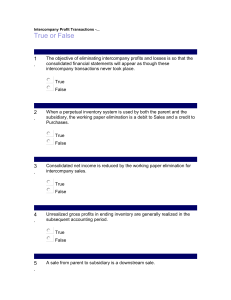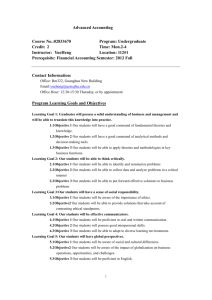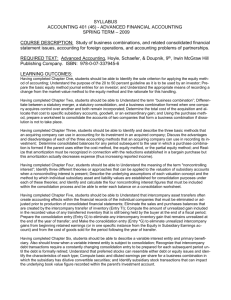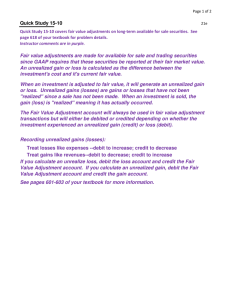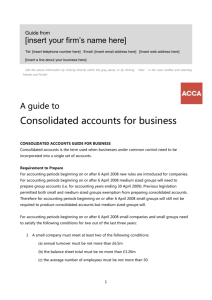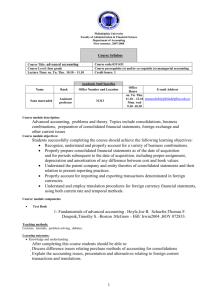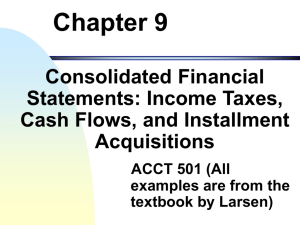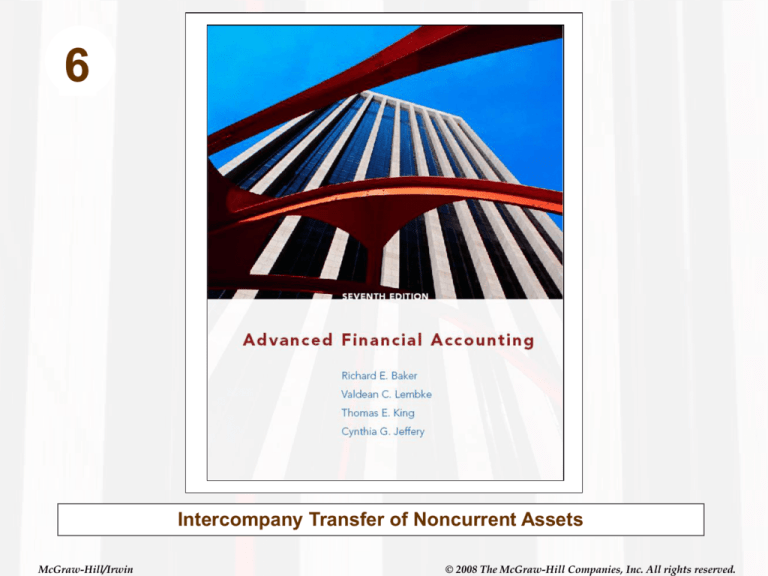
6
Intercompany Transfer of Noncurrent Assets
McGraw-Hill/Irwin
© 2008 The McGraw-Hill Companies, Inc. All rights reserved.
6-2
Intercorporate Transfers
• A parent company and its subsidiaries
often engage in a variety of transactions
among themselves.
• For example, manufacturing companies
often have subsidiaries that develop raw
materials or produce components to be
included in the products of affiliated
companies.
6-3
Intercorporate Transfers
• These transactions between related
companies are referred to as
intercorporate transfers.
6-4
Intercorporate Transfers
• Because single companies are not
permitted to reflect internal transactions in
their financial statements, consolidated
entities must exclude from their financial
statements the effects of transactions.
6-5
Intercorporate Transfers
• All aspects of intercorporate transfers must be
eliminated in preparing consolidated financial
statements so that the statements appear as
if they were those of a single company.
6-6
Intercorporate Transfers
• Once the conditions for consolidation are met,
a company becomes part of a single economic
entity and all transactions with related
companies become internal transfers that must
be eliminated fully, regardless of the level of
ownership held.
6-7
Unrealized Profits and Losses
• Profit or loss from selling an item to a related
party normally is considered realized at the time
of the sale from the selling company’s
perspective, but the profit is not considered
realized for consolidation purposes until resold
to an unrelated party.
• This unconfirmed profit from an intercorporate
transfer is referred to as unrealized
intercompany profit.
6-8
Intercompany Transfers of Land
• When intercorporate transfers of noncurrent
assets occur, adjustments often are needed
in the preparation of consolidated financial
statements for as long as the assets are held
by the acquiring company.
• The simplest example of an intercorporate
asset transfer is the intercorporate sale of land.
6-9
Transfer of Land at Book Value
• When land is transferred between related
companies at book value, no adjustments
or eliminations are needed.
• Because no gain or loss is recorded by the
seller both income and assets are stated
correctly from a consolidated viewpoint.
6-10
Transfer of Land at a Gain or Loss
• Land transfers at more or less than book value
requires special treatment in the consolidation
process.
• The selling entity’s gain or loss must be
eliminated because the land is still held by the
consolidated entity. No gain or loss may be
reported in the consolidated financial statements
until the land is sold to an unrelated party.
6-11
Transfer of Land at a Gain or Loss
• Likewise, the land must be reported at its
original cost in the consolidated financial
statements as long as it is held within the
consolidated entity, regardless of which
affiliate holds the land.
6-12
Example
• Assume that one affiliate sells land to another
affiliate for $15,000 more than book value. The
intercorporate transfer causes the seller to
recognize a $15,000 gain and the carrying value
of the land to increase by the same amount.
• Neither of these amounts may be reported in the
consolidated financial statements because the
$15,000 intercompany gain is unrealized from a
consolidated viewpoint.
6-13
Example-Continued
• The land has not been sold to a party outside
the consolidated entity; consequently, the land
must be reported at its original cost to the
consolidated entity and the gain must be
eliminated as follows:
Gain on Sale of Land
Land
15,000
15,000
6-14
Unrealized Profit Elimination
• Generally, gains and losses are not considered
realized by the consolidated entity until a sale is
made to an external party.
• Unrealized gains and losses are eliminated in
preparing consolidated financial statements
against the shareholders of the selling affiliate.
• Therefore, the direction of the sale
determines which shareholder group
absorbs the elimination of unrealized
intercompany gains and losses.
6-15
Unrealized Profit Elimination
• When a sale is from a parent to a subsidiary,
referred to as a downstream sale, any gain or
loss on the transfer accrues to the stockholders
of the parent company.
• When a sale is from a subsidiary to its parent,
an upstream sale, any gain or loss accrues to
the stockholders of the subsidiary.
6-16
Unrealized Profit Elimination
• If the subsidiary is wholly owned, all the gain or
loss ultimately accrues to the parent company
as the sole stockholder.
• If, however, the selling subsidiary is not wholly
owned, the gain or loss on the upstream sale is
apportioned between the parent company and
the noncontrolling shareholders.
6-17
Unrealized Profit Elimination
• If the sale is a downstream transfer, all the
unrealized profit is eliminated from the
controlling interest’s share of income when
consolidated statements are prepared.
• If, instead, the intercompany transfer is from
subsidiary to parent, the unrealized profit on
the upstream sale is eliminated proportionately
from the interests of the controlling and
noncontrolling shareholders.
6-18
Unrealized Profit Elimination
• For example, assume that the unrealized
gain is $10,000 and the parent owns 75%
of the subsidiary.
• The reduction in consolidated net income is
$2,500 less in the upstream case because 25%
of the unrealized profit elimination is deducted
from the noncontrolling interest rather than
deducting the full amount from the controlling
interest as in the downstream case.
6-19
Unrealized Profit Elimination
• Note that unrealized intercompany gains and
losses are always fully eliminated in preparing
consolidated financial statements.
• The existence of a noncontrolling interest in a
selling subsidiary affects only the allocation of
the eliminated unrealized gain or loss and not
the amount eliminated.
6-20
Elimination after the First Year
• In the period in which unrealized profit arises from
an intercorporate sale, workpaper eliminating
entries are used in the consolidation process to
remove the gain or loss recorded by the seller and
to adjust the reported amount of the asset back to
the price originally paid by the selling affiliate.
• Each period thereafter while the asset is held by
the purchasing affiliate, the reported asset balance
and the shareholder claims of the selling affiliate
are adjusted to remove the effects of the
unrealized gain or loss. Income in those
subsequent periods is not affected.
6-21
Elimination after the First Year
• In the case of a downstream sale, the profit on
the intercompany transfer is recognized entirely
by the parent and is included in the parent’s
retained earnings in subsequent years.
• Therefore, the following eliminating entry is
needed in the consolidation workpaper each
year after the year of the downstream sale of
the land, for as long as the land is held by the
subsidiary:
Retained Earnings, January 1 $15,000
Land
$15,000
6-22
Elimination after the First Year
• In the upstream case, the intercompany profit is
recognized by the subsidiary. The parent
recognizes its proportionate share of the gain, and
that amount is included in the parent’s beginning
retained earnings in the subsequent years. The
unrealized intercompany gain is eliminated from the
reported balance of the land and proportionately
from the subsidiary ownership interests with the
following entry:
Retained Earnings, January 1
$12,000
Noncontrolling Interest
$3,000
Land
$15,000
6-23
Subsequent Disposition of Asset
• When previously unrealized intercompany
profits are realized (sold to external party), the
effects of the profit elimination process must be
reversed.
• At the time of realization, the full amount of
the deferred intercompany profit is added
back into the consolidated income computation
and assigned to the shareholder interests from
which it originally was eliminated.
6-24
Subsequent Disposition of Asset
• In the consolidation workpaper, the land no longer
needs to be reduced by the unrealized
intercompany gain because the gain now is realized
and the land no longer is held by the consolidated
entity. The following eliminating entry is made in the
consolidation workpaper prepared in the year that
the land sold by the parent to a subsidiary is resold
to external parties:
Retained Earnings, January 1
$15,000
Gain on Sale of Land
$15,000
6-25
Intercompany Transfers of Depreciable
Assets
• Unrealized intercompany profits on a
depreciable or amortizable asset are viewed
as being realized gradually over the remaining
economic life of the asset as it is used by the
purchasing affiliate in generating revenue from
unaffiliated parties.
• In effect, a portion of the unrealized gain or loss
is realized each period as benefits are derived
from the asset and its service potential expires.
6-26
Intercompany Transfers of Depreciable
Assets
• The amount of depreciation recognized on a
company’s books each period on an asset
purchased from an affiliate is based on the
intercorporate transfer price.
• From a consolidated viewpoint, however,
depreciation must be based on the cost of
the asset to the consolidated entity, which is
the cost of the asset to the related company
that originally purchased it from an outsider.
6-27
Intercompany Transfers of Depreciable
Assets
• Eliminating entries are needed in the
consolidation workpaper to restate the
asset, accumulated depreciation, and
depreciation expense to the amounts that
would appear in the financial statements if
there had been no intercompany transfer.
6-28
Downstream Sale
• Parent sells equipment to Subsidiary on
December 31, 20X1 for $7,000. The equipment
was purchased by Parent three years earlier at a
cost of $9,000. Depreciation on the equipment
was calculated based on a total life of ten years
using straight-line depreciation with no residual
value. The Subsidiary will depreciate the assets
on Straight-line method with $0 salvage value
and 7 year life.
• Continued on next slide.
6-29
Consolidation Entry
The following entry is needed to eliminate the
effects of the intercompany transaction in the year
of the transfer (20X1):
Buildings and Equipment (9,000-7,000) $2,000
Gain on Sale of Equipment
$700
Accumulated Depreciation
$2,700 *
* $2,700 = (9,000)(0.10)(3)
6-30
Consolidation Entry
The following entry is needed to eliminate the
effects of the 20X1 intercompany transaction as
of the beginning of 20X2:
Buildings and Equipment (9,000-7,000)
Retained Earnings, January 1
Accumulated Depreciation
* $2,700 = (9,000)(0.10)(3)
Accumulated Depreciation
$100
Depreciation Expense
$2,000
$700
$2,700 *
$100
6-31
Upstream Sale
• The treatment of unrealized profits arising from
upstream intercompany sales is identical to that
of downstream sales except that the unrealized
profit, and subsequent realization, must be
allocated between the controlling and
noncontrolling interests.
6-32
Consolidation Entry
The following entry is needed to eliminate the
effects of the intercompany transaction in the year
of the transfer (20X1):
Buildings and Equipment (9,000-7,000) $2,000
Gain on Sale of Equipment
$700
Accumulated Depreciation
$2,700 *
* $2,700 = (9,000)(0.10)(3)
6-33
Consolidation Entry
The case of an upstream sale can be illustrated at
the beginning of 20X2 using the same facts as
for the previous downstream example.
Buildings and Equipment (9,000-7,000)
Retained Earnings, January 1 (0.8)(700)
Noncontrolling Interest (0.2)(700)
Accumulated Depreciation
$2,000
$560
$140
$2,700
Accumulated Depreciation
Depreciation Expense
$100
$100
6-34
Intercompany Transfers of Services
• Related companies frequently purchase services
from one another.
• These services may be of many different types,
but intercompany purchases of consulting,
engineering, marketing, and maintenance
services are common.
• When consolidated financial statements are
prepared, both the expense and revenue must
be eliminated.
6-35
Intercompany Transfers of Services
• For example, if the parent sells consulting
services to the subsidiary for $50,000, the
parent would recognize $50,000 of consulting
revenue on its books and the subsidiary would
recognize $50,000 of consulting expense.
• In the consolidation workpaper, an eliminating
entry would be needed to reduce both consulting
revenue (debit) and consulting expense (credit)
by $50,000.
6-36
Intercompany Transfers of Services
• Because the revenue and expense are equal
and both are eliminated, income is unaffected
by the elimination.
• Even though income is not affected, the
elimination is still important, however, because
otherwise both revenues and expenses are
overstated.

